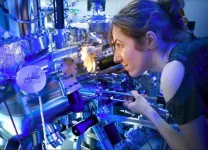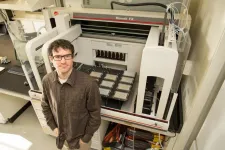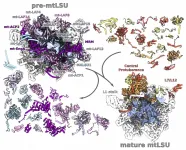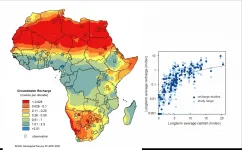Tapping into waste heat for electricity by nanostructuring thermoelectric materials
Scientists develop a relatively simple synthesis strategy to produce high-performance tin telluride nanosheets, a promising thermoelectric material
2021-02-16
(Press-News.org) In our ongoing struggle to reduce the usage of fossil fuel, technology to directly convert the world's waste heat into electricity stands out as very promising. Thermoelectric materials, which carry out this energy conversion process, have, thus, recently become the focus of intense research worldwide. Of the various potential candidates applicable at a broad range of temperatures, between 30 and 630 °C, lead telluride (PbTe) offers the best thermoelectric performance. Unfortunately, the outstanding qualities of PbTe are eclipsed by the toxic nature of lead, driving researchers to look into safer thermoelectric semiconductors.
Tin telluride (SnTe) could be an alternative. But it does not perform nearly as well as PbTe, and various methods to improve its thermoelectric performance are actively being studied. There are two main problems with SnTe that lower its figure of merit (ZT): its high thermal conductivity and its low Seebeck coefficient, which determines how large the generated thermoelectric voltage is as a function of temperature. Although researchers have managed to improve these parameters separately, it has proven difficult to do so for both simultaneously in the case of SnTe.
In a recent study published in Chemical Engineering Journal, a pair of scientists from Chung-Ang University, Korea--Dr. Jooheon Kim and Hyun Ju--came up with an effective strategy to solve this problem. Their approach is based on nanostructuring--producing a material with desired structural properties at the nanometer scale. In this particular case, the scientists produced porous SnTe nanosheets. However, making nanosheets out of SnTe is remarkably complex using standard procedures, which prompted the scientists to devise an innovative synthesis strategy.
They took advantage of another semiconductor: tin selenide (SnSe). This material bears a layered structure that is relatively easy to exfoliate to produce SnSe nanosheets. The researchers submerged these nanosheets in a solution of tartaric acid (C4H6O6) and pure Te under a nitrogen atmosphere to prevent oxidation. What C4H6O6 does is extract Sn-Se pairs from the SnSe nanosheets, thereby allowing for the dissolved Te? anions to naturally replace the Se? anion in the extracted pairs. Then, the Sn-Te pairs rejoin the original nanosheet in a slightly 'imperfect' way, creating pores and grain boundaries in the material. The result of this whole process is anion-exchanged porous SnTe nanosheets.
The scientists investigated the reaction mechanisms that made these SnTe nanosheets possible and carefully searched for the synthesis conditions that produced the optimal nanoscale morphology. "We found that the nanostructure of the optimal anion-exchanged porous SnTe nanosheets, composed of nanoparticles of only 3 nm in size with defective shapes, led to a substantial reduction in thermal conductivity and a higher Seebeck coefficient compared to conventional bulk SnTe," remarks Kim. "This is a direct result of the introduced nanointerfaces, pores, and defects, which help to 'dissipate' otherwise uniform vibrations in SnTe known as phonons, which compromise thermoelectric properties," he adds. The ZT of the best-performing SnTe nanosheets was 1.1 at a temperature of 650 °C; that is almost three times higher than that of bulk SnTe.
The overall results of the study are very promising in the field of high-performance thermoelectric materials, which is bound to find applications not only in energy generation, but also refrigeration, air conditioning, transportation, and even biomedical devices. Equally important, however, is the insight gained by exploring a new synthesis strategy, as Kim explains: "The unconventional method we employed to obtain porous SnTe nanosheets could be relevant for other thermoelectric semiconductors, as well as in the fabrication and research of porous and nanostructured materials for other purposes."
Most importantly, with thermal energy harvesting being the most sought-after application of thermoelectric materials, this study could help industrial processes become more efficient. Thermoelectric semiconductors will let us tap into the large amounts of waste heat produced daily and yield useful electrical energy, and further research in this field will hopefully pave the way to a more ecofriendly society.
INFORMATION:
Reference
Authors: Hyun Ju, Jooheon Kim
Title of original paper: Anion-exchanged porous SnTe nanosheets for ultra-low thermal conductivity and high-performance thermoelectrics
Journal: Chemical Engineering Journal
DOI: 10.1016/j.cej.2020.126274
Affiliations:
School of Chemical Engineering & Materials Science, Chung-Ang University
Department of Advanced Materials Engineering, Chung-Ang University
About Chung-Ang University
Chung-Ang University is a private comprehensive research university located in Seoul, South Korea. It was started as a kindergarten in 1918 and attained university status in 1953. It is fully accredited by the Ministry of Education of Korea. Chung-Ang University conducts research activities under the slogan of "Justice and Truth." Its new vision for completing 100 years is "The Global Creative Leader." Chung-Ang University offers undergraduate, postgraduate, and doctoral programs, which encompass a law school, management program, and medical school; it has 16 undergraduate and graduate schools each. Chung-Ang University's culture and arts programs are considered the best in Korea.
Website: https://neweng.cau.ac.kr/index.do
About Dr. Jooheon Kim
Dr. Jooheon Kim is a Professor of Chemical Engineering & Materials Science and Dean of the Department of Advanced Materials Engineering at Chung-Ang University. He is also an Executive Director for Academic Affairs of a graduate school. His group is researching nanotechnology-based inorganic, organic, and composite materials for the applications of thermal dissipation, batteries, hydrogen and oxygen evolution, thermoelectrics, and 3D/4D photoreactive printing. Before joining Chung-Ang university, he completed a postdoctoral training course at the Texas Materials Institute of the University of Texas, Austin, USA.
ELSE PRESS RELEASES FROM THIS DATE:
2021-02-16
Ben-Gurion University Researchers Uncover a Catch-22 When It Comes to Social Media Online Support Groups and Privacy Concerns
BEER-SHEVA, Israel...February 16, 2021- People who seek support online social media groups may end up not getting the help they need due to privacy concerns, according to a new study by Ben-Gurion University of the Negev (BGU) and Gutenberg University in Sweden.
The new research, published in END ...
2021-02-16
Could long-distance interactions between individual molecules forge a new way to compute?
Interactions between individual molecules on a metal surface extend for surprisingly large distances - up to several nanometers.
A new study, just published, of the changing shape of electronic states induced by these interactions, has potential future application in the use of molecules as individually addressable units.
For example, in a future computer based on this technology, the state of each individual molecule could be controlled, mirroring binary operation of transistors in current computing.
MEASURING SOCIALLY-DISTANT MOLECULAR INTERACTIONS ON A METAL SURFACE
The Monash-University of Melbourne collaboration studied the electronic properties of ...
2021-02-16
The placement of a wet cotton pellet against Mineral Trioxide Aggregate (MTA) is often recommended to ensure the completion of its setting reaction. This study aimed to evaluate the setting behaviour of MTA Angelus and NeoMTA by comparing their hardness after placing them in dry and moist conditions.
A simulated open apex was created on 40 polyvinyl tubes. The apical 4 mm of the tubes was filled with the two materials, NeoMTA Plus (Avalon Biomed Inc. Bradenton, FL, USA) and MTA Angelus (Angelus, Londrina, PR, Brazil) (n=20 per group). Both groups were subdivided into two subgroups based on the dry and wet conditions (n=10 per group). A wet cotton pellet was placed above the ...
2021-02-16
The schools in Vietnam observe a phenomenon that almost all parents send their children to school using private vehicles, mostly motorcycles. The parents usually park their vehicle on streets outside the school gates which can cause serious congestion and chances of of traffic accidents.
This study aims to identify the factors affecting the picking up of pupils at primary school by analysing typical primary schools in Hanoi city. The researchers used the binary logistic regression model to determine the factors that influence the decision of picking up pupils and the waiting duration of parents. The behaviour of motorcyclists during the process ...
2021-02-16
If B is better than A, and C is better than B, it follows by the transitive property that C is better than A. And, yet, this is not always the case. Every kid is familiar with the Rock-Paper-Scissors game--the epitome of nontransitivity in which there is no clear hierarchy among the three choices, despite each two-way interaction having a clear winner: Paper beats Rock, Scissors beats Paper, and Rock beats Scissors.
Evolution may be teeming with nontransitive interactions as well. While natural selection - the process by which organisms better adapted to their environments are more likely ...
2021-02-16
A new USC study puts ocean microbes in a new light with important implications for global warming.
The study, published Tuesday in the Proceedings of the National Academy of Sciences, provides a universal accounting method to measure how carbon-based matter accumulates and cycles in the ocean. While competing theories have often been debated, the new computational framework reconciles the differences and explains how oceans regulate organic carbon across time.
Surprisingly, most of the action involving carbon occurs not in the sky but underfoot and undersea. The Earth's plants, ...
2021-02-16
The mitochondrial ribosome is an intricate machine that translates the organellar genome into functional proteins. The formation of the mitochondrial ribosome is a hierarchical process involving dozens of different components. The newly published cryo-EM study by Tobiasson et al in the EMBO Journal characterized a key step in this process.
A complex of 2.2 MegaDalton representing a rare state of assembly of the large subunit was isolated from a model organism Trypanosoma brucei. Since the state was identified in only 3.5 % of the complexes, five cryo-EM datasets had to be collected at the SciLifeLab facility and ESRF in Grenoble and combined together.
The resulting structure revealed ...
2021-02-16
A new study published in Nature Communications suggests that the extinction of North America's largest mammals was not driven by overhunting by rapidly expanding human populations following their entrance into the Americas. Instead, the findings, based on a new statistical modelling approach, suggest that populations of large mammals fluctuated in response to climate change, with drastic decreases of temperatures around 13,000 years ago initiating the decline and extinction of these massive creatures. Still, humans may have been involved in more complex and indirect ways than simple models of overhunting suggest.
Before around 10,000 years ago, North America was ...
2021-02-16
Effective governance and investment decisions need to be informed by reliable data, not only about where groundwater exists, but also the rate at which groundwater is replenished. For the first time using ground measurements, a recent study has quantified groundwater recharge rates across the whole of Africa - averaged over a fifty-year period - which will help to identify the sustainability of water resources for African nations.
The study, led by the British Geological Survey and involving an international team from the UK, South Africa, France, Nigeria, and America, developed a dataset of 134 existing recharge studies ...
2021-02-16
Gender equity and racial diversity in medicine can promote creative solutions to complex health problems and improve the delivery of high-quality care, argue authors in an analysis in CMAJ (Canadian Medical Association Journal).
"[T]here is no excuse for not working to change the climate and environment of the medical profession so that it is welcoming of diversity," writes lead author Dr. Andrea Tricco, Knowledge Translation Program, Unity Health, and the University of Toronto, with coauthors. "The medical profession should be professional, be collegial, show mutual respect, and facilitate the full potential and contribution of all genders, races, ethnicities, religions and nationalities for the benefit of patient ...
LAST 30 PRESS RELEASES:
[Press-News.org] Tapping into waste heat for electricity by nanostructuring thermoelectric materials
Scientists develop a relatively simple synthesis strategy to produce high-performance tin telluride nanosheets, a promising thermoelectric material




